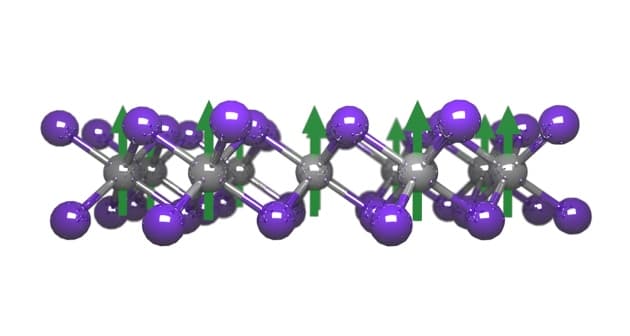Newly discovered 2D magnet to be pivotal in future applications of storage and communications
The advent of the wonder material 'Graphene' has ushered the era of two-dimensional materials that display electronics properties. However, none of these 2D materials could exhibit magnetic properties, until now. A team from University of Washington and Massachusetts Institute of Technology has discovered a 2D magnet made up of monolayers (single atomic layers) that could make our hard-disk storage devices even smaller and make them operate at much faster speeds. The researchers have published a paper detailing their techniques in the journal #-Link-Snipped-#.
 The team of scientists has discovered an isolated 2-D material that possesses intrinsic magnetic properties and they believe that new information technologies could spring forth on the basis of these new 2-D magnets. The material that showed magnetic properties in its monolayer form is called chromium triiodide (CrI3). Its ferromagnetic nature makes its constituent electrons 'spin' in the same direction without the application of an external magnetic field.
The team of scientists has discovered an isolated 2-D material that possesses intrinsic magnetic properties and they believe that new information technologies could spring forth on the basis of these new 2-D magnets. The material that showed magnetic properties in its monolayer form is called chromium triiodide (CrI3). Its ferromagnetic nature makes its constituent electrons 'spin' in the same direction without the application of an external magnetic field.
It's interesting to note that until now, no 3-D magnetic substance could retain its magnetism when stripped down to a single atomic sheet or 2-D form. The team made use of 'Scotch Tape' (the same, low-cost method used to obtain Graphene), for scraping down the 3D crystals into its monolayer 2D form.
To demonstrate the intrinsic ferromagnetism, the scientists used a special microscopy method to project a beam of polarized light on to CrI3 and it proved that the aligned electron spins left a telltale signature. However, the signature disappeared in two-layer CrI2, which indicated that the electron spins were oppositely aligned to one another - showcasing what's called "antiferromagnetic ordering".
It got interesting when the ferromagnetism was retained in three-layer CrI3. The team is, therefore, studying why CrI3 displays such layer-dependent magnetic phases.
What are your thoughts about the newly found 2-D magnets and its applications in computing, storage as well as communications? Share with us in comments below.
Source: <a href="https://www.washington.edu/news/2017/06/07/scientists-discover-a-2-d-magnet/" target="_blank" rel="noopener noreferrer">www.washington.edu</a>

It's interesting to note that until now, no 3-D magnetic substance could retain its magnetism when stripped down to a single atomic sheet or 2-D form. The team made use of 'Scotch Tape' (the same, low-cost method used to obtain Graphene), for scraping down the 3D crystals into its monolayer 2D form.
To demonstrate the intrinsic ferromagnetism, the scientists used a special microscopy method to project a beam of polarized light on to CrI3 and it proved that the aligned electron spins left a telltale signature. However, the signature disappeared in two-layer CrI2, which indicated that the electron spins were oppositely aligned to one another - showcasing what's called "antiferromagnetic ordering".
It got interesting when the ferromagnetism was retained in three-layer CrI3. The team is, therefore, studying why CrI3 displays such layer-dependent magnetic phases.
What are your thoughts about the newly found 2-D magnets and its applications in computing, storage as well as communications? Share with us in comments below.
Source: <a href="https://www.washington.edu/news/2017/06/07/scientists-discover-a-2-d-magnet/" target="_blank" rel="noopener noreferrer">www.washington.edu</a>
0
